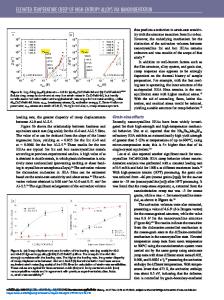Creep Behavior of Shale: Nanoindentation vs. Triaxial Creep Tests
- PDF / 3,374,481 Bytes
- 15 Pages / 595.276 x 790.866 pts Page_size
- 92 Downloads / 456 Views
ORIGINAL PAPER
Creep Behavior of Shale: Nanoindentation vs. Triaxial Creep Tests Kouqi Liu2,3,4 · Fatemeh S. Rassouli5 · Bo Liu1 · Mehdi Ostadhassan1,6 Received: 18 October 2019 / Accepted: 16 September 2020 © Springer-Verlag GmbH Austria, part of Springer Nature 2020
Abstract In this study, three shale samples from the Wolfcamp Formation in Permian basin were selected and studied for creep behavior using two different methods at macro- and micro-scale: triaxial and nanoindentation creep tests. The triaxial creep test showed the effects of axial differential stress on the creep behavior of shale rocks including the strain and contact creep modulus. As the axial differential stress increased, the creep strain value presented an increasing trend. Additionally, based on the grid nanoindentation creep experiments, three different mechanical phases were recognized in these samples; Phase 1: soft mechanical phase, Phase 2: intermediate, and Phase 3: hard mechanical phase. Based on the micro-scale results, at the same creep time periods, phase 1 (clay + organic matter) was found to have a smaller contact creep modulus and larger creep strain value than Phase 3 (quartz). Comparing the results from these two scales of measurements, the contact creep modulus from the triaxial test and the homogenized contact creep modulus from nanoindentation experiments showed some discrepancies. Based on the samples in this study, the contact creep modulus from the triaxial test varied from 0.5 to 4 times the value of the nanoindentation test. The differences between the contact creep modulus from the nanoindentation and triaxial test could be due to the creep strain amplitude. Considering Sample 1 as an example, the creep strain amplitude under the nanoindentation is inferred to be 0.069 which is not equal to the creep strain amplitude from the triaxial test (0.0052 under differential stress of 30 MPa). Ultimately, the contact creep modulus from the nanoindentation can fluctuate based on the samples’ content, while the reason for this is still a question that needs further study. Overall, this study is a preliminary investigation to help us understand how nanomechanical data in complex geomaterials can relate to traditional triaxial data. Keywords Creep · Shale · Nanoindentation · Triaxial test
1 Introduction * Fatemeh S. Rassouli [email protected] * Mehdi Ostadhassan [email protected]; [email protected] 1
Key Laboratory of Continental Shale Hydrocarbon Accumulation and Efficient Development, Ministry of Education, Northeast Petroleum University, Daqing 163318, China
2
State Key Laboratory of Petroleum Resources and Prospecting, China University of Petroleum, Beijing 102249, China
3
College of Geosciences, China University of Petroleum, Beijing 102249, China
4
Department of Earth and Atmospheric Sciences, Central Michigan University, Mount Pleasant, MI 48859, USA
5
Department of Geophysics, Stanford University, Stanford, CA, USA
6
Department of Petroleum Engineering, Amirkabir University of Techno
Data Loading...











